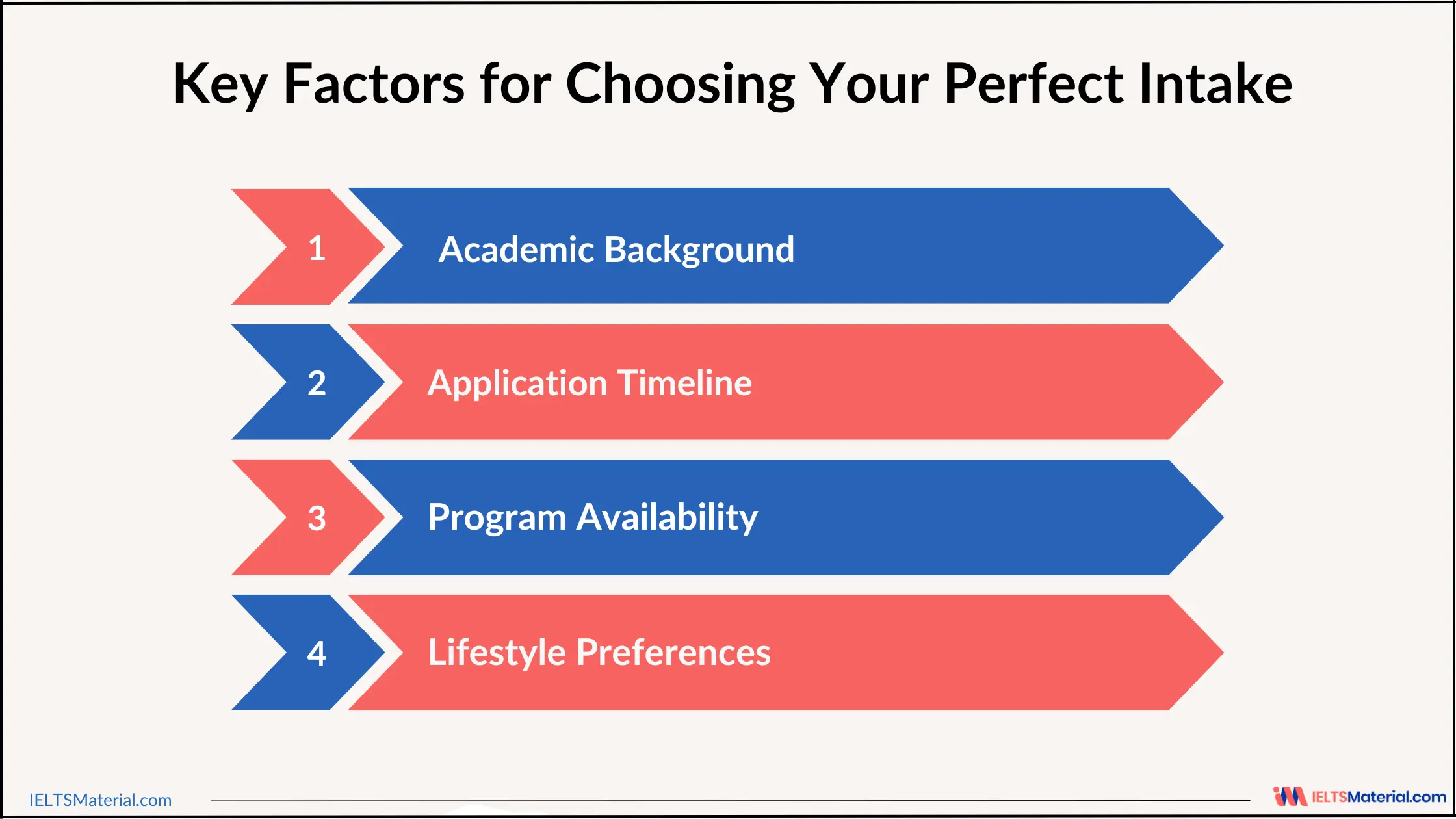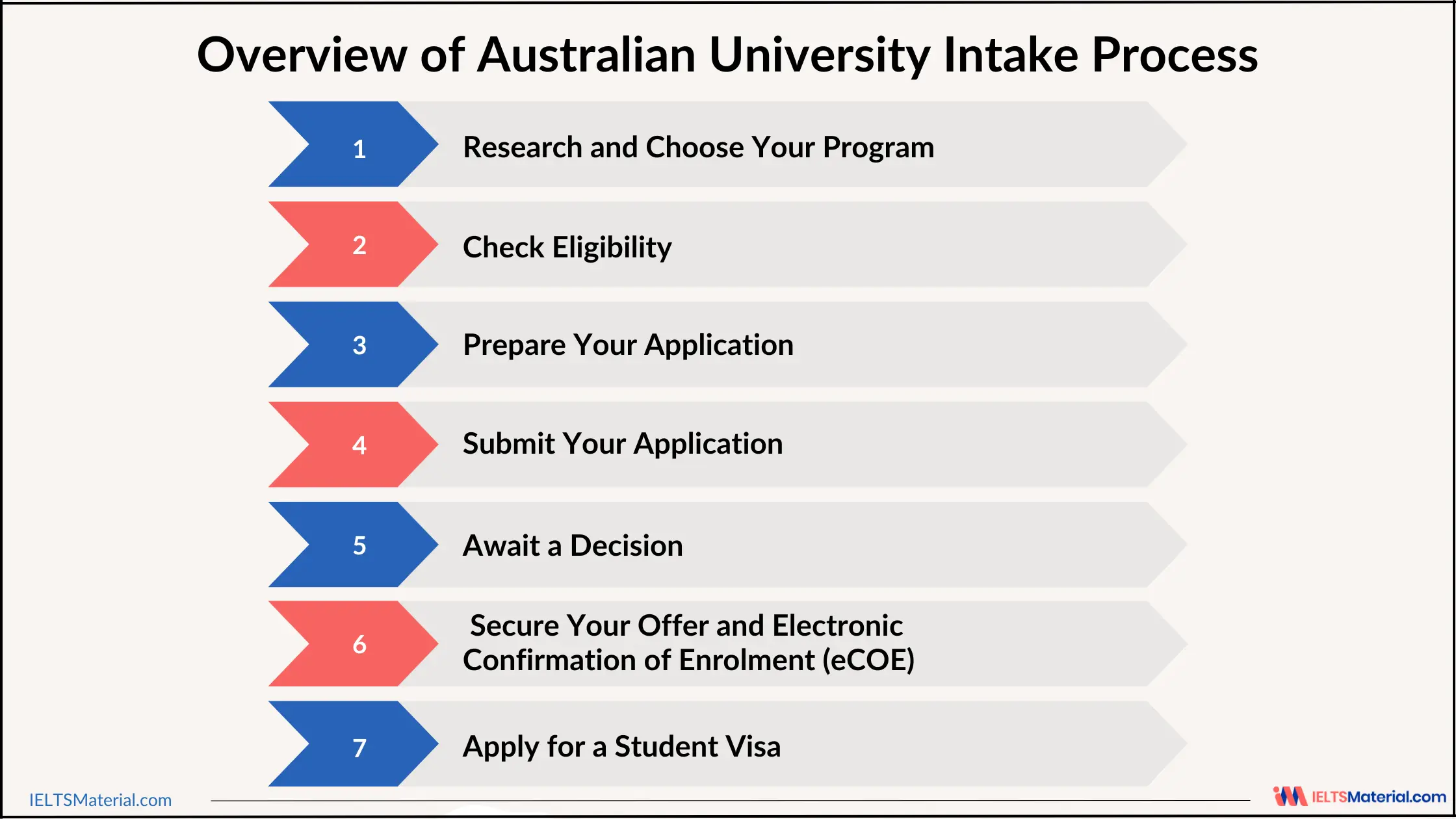Intakes in Australia for International Students: Process, Documents & Eligibility
9 min read
Updated On
-
Copy link
Planning to study in Australia? Dive into the Intakes in Australia for International Students: Process, Documents & Eligibility and check the essential required documentation while familiarising yourself with the application process.
Table of Contents
- Key Highlights of Intakes in Australia 2025-26
- Importance of Intakes in Australia for International Students
- Key Factors for Choosing the Right Intakes in Australia for International Students: Process, Documents & Eligibility
- Eligibility for Intakes in Australia for International Students
- Essential Documents Required for Intakes in Australia for International Students
- Application Process for Intakes in Australia for International Students

Limited-Time Offer : Access a FREE 10-Day IELTS Study Plan!
Australia is known as one of the top places due to its top universities, multicultural lifestyle, and work opportunities. For international students who want to move to Australia as their next study destination, it is important to be familiar with the major Intakes in Australia for International Students: Process, Documents & Eligibility. Having a clear idea of the major intakes in Australia, i.e. February, July, and November is crucial. These intakes are basically different starting dates for your studies.
It can seem overwhelming initially, but there’s no need to worry. This guide aims to clarify everything for you starting from the key highlights to the process, documentation, and eligibility. We’ll simplify the intake process for international students, allowing you to apply with confidence. Therefore, it is crucial to understand the Australian educational intake system in order to plan your application process, increasing your chances of success.
Let's get started!
Key Highlights of Intakes in Australia 2025-26
There is great competition as Australia remains one of the most sought after students pursuing studying abroad due to the cultural richness, variety of academic programs, and potential career opportunities. Understanding the intake in Australia for 2025-26 is essential. Popular intake months include February/March, July, October/November, and January, each with its own corresponding application deadlines or seasons.
| Intake Period | Popularity | Application Deadline | Details |
| February Intake | Popular for Semester 1 start; includes a wide range of disciplines | Between February or early March and extending through late May or early June | The most popular intake |
| July Intake | Popular for Semester 2 start; offers diverse academic programs | From early July or early August extending through November | The second-largest intake |
| November Intake | Increasingly popular for some universities; particularly for mid-year programs | From late November to January | A minor intake |
Importance of Intakes in Australia for International Students
As an international student, it is vital for you to get familiar with the intakes in Australia. This will not only make you prepared with the relevant documentation but also helps you to apply within the specific deadlines. Since there are three major intakes in Australia, you must be aware of when to apply and which intake would be preferable for you. Each intake in Australia for international students has its respective advantages and therefore, you should make the right decision when to apply in Australia. The following are the importance of each intake in Australia.
1. February Intake in Australia
This is the most common and popular intake, often considered the official “start of the academic year” for many universities. Think of it as the fall semester in other countries. It falls around late February to early March and offers the widest selection of programs and courses.
- Ideal for recent high school graduates or those seeking a fresh academic start.
- Offers the most program and course options for flexibility.
- Allows for full immersion in the academic year and vibrant campus life.
2. July Intake in Australia
This is a smaller intake happening around late July to early August. It offers a chance to begin your studies in the middle of the year, which can be ideal if you need more time to prepare your application or finish current commitments. Keep in mind that not all universities offer a July intake, and the course selection might be slightly limited compared to February.
- Perfect if you need more time to prepare your application materials.
- Ideal if you have current commitments to finish before starting studies.
- A good option if you prefer a mid-year start to the academic year.
3. November Intake in Australia
This intake is the least common, happening around November. It’s a good option if you have a very specific reason for wanting to start later in the year, but be aware that very few universities offer it and the program selection might be very limited.
- Ideal for those with a very specific reason for a later start (e.g., finishing military service).
- May be suitable if a program you desire is only offered in November.
Key Factors for Choosing the Right Intakes in Australia for International Students: Process, Documents & Eligibility
For many international students, studying in Australia is an absolute dream due to its high quality universities and multicultural society. There’s no single best intake where the ideal one depends on your individual circumstances and goals. Here are some factors to consider while choosing the right intakes in Australia for international students.

- Academic Background: Are you a recent high school graduate or transferring from another institution? February might be ideal for a fresh start.
- Application Timeline: Do you need more time to prepare your application materials? July could be a good fit.
- Program Availability: Check with your chosen university to see which programs are offered in each intake.
- Lifestyle Preferences: Do you want to experience the full academic year or prefer a mid-year start?
Eligibility for Intakes in Australia for International Students
Every intake has its own set of admission criteria, application cut-off dates, and courses offered. With this knowledge, it would support students at all levels such as undergraduate, postgraduate, or vocational, helping you in academic, linguistic, and scheduling needs. Dreaming of studying in Australia? Understanding the eligibility criteria for university intakes is the first step toward making your dream a reality. Here’s a comprehensive breakdown of the key factors universities consider:
1. Academic Qualifications
- You’ll need to have completed the equivalent of an Australian high school diploma (Year 12) or a recognized foundation program.
- Specific programs may require additional qualifications or prerequisites related to the field of study (e.g., advanced math for engineering).
- Meeting minimum GPA (Grade Point Average) requirements from your previous studies is often crucial.
2. English Language Proficiency
- International students must demonstrate English proficiency through standardized tests like IELTS or TOEFL.
- Each university and program set minimum score requirements you must achieve on these tests (typically ranging from 6.0 to 7.0 on IELTS).
3. Visa Requirements
- Meeting the eligibility criteria for a student visa includes factors like:
- Having a confirmed place in a registered program at an Australian university.
- Demonstrating sufficient financial resources to support yourself throughout your studies (tuition fees and living expenses).
- Fulfilling health insurance requirements by having Overseas Student Health Cover (OSHC).
- The specific visa application process and requirements can vary depending on your nationality and study program.
Join our expert-led classes to achieve your desired IELTS band score. Enroll Now!
Essential Documents Required for Intakes in Australia for International Students
Australia is one of the most popular destinations for international students looking for best educational institutions and multicultural opportunities offered for future career prospects and global exposure. Having confirmed your eligibility, it’s time to gather the documents that will make your application shine. A strong application portfolio paints a clear picture of your academic achievements and potential for success. Here’s a detailed breakdown of the essential documents universities in Australia typically require for international student intakes:
1. Academic Transcripts and Certificates
- Official documents from your high school and any past colleges/universities showcasing your academic history.
- These documents are the foundation of your application, proving your academic achievements and course work. They demonstrate your readiness for the rigors of your chosen program.
2. Proof of English Language Proficiency
- Results from standardized tests like IELTS or TOEFL, demonstrating your English language skills.
- As most Australian universities operate in English, meeting the minimum score requirement on these tests ensures you can effectively understand lectures, participate in discussions, and complete coursework in English.
3. Photograph
A recent passport-sized photograph is often required for identification purposes. It should be clear, and professional, and adhere to the specified dimensions and background requirements set by the institution or visa office.
4. CV/Resume
A CV or resume provides a detailed summary of your educational background, work experience, skills, and achievements. It helps institutions and employers assess your qualifications and suitability for the program or job you are applying for.
5. Electronic Confirmation of Enrolment (eCOE)
- An official document issued by the university after accepting your application.
- This document confirms your place in the program and is vital for obtaining a student visa, allowing you to study in Australia legally.
6. Valid Passport
- Your official travel document with sufficient validity (usually at least 6 months beyond your study period).
- A valid passport is essential for traveling to Australia and serves as identification throughout your studies.
7. Visa Application Fee
- A government fee is charged for processing your student visa application.
- Payment of this fee is mandatory for your visa application to be considered. Research current fees and ensure you use the appropriate payment method.
8. Genuine Temporary Entrant (GTE) Statement
- A written explanation outlining your genuine reasons for studying in Australia and your future plans after graduation.
- This statement convinces visa authorities that your primary purpose is to study, and you intend to return to your home country upon completion of your program.
9. Evidence of Financial Ability
- Proof of sufficient financial resources to support yourself throughout your studies in Australia. This could include bank statements, scholarship letters, or evidence of financial sponsorship.
- Demonstrating financial stability is crucial. It assures the government you can cover your living expenses and tuition fees during your stay.
10. Character Documents
- Documents verifying your good character, such as police checks or character reference letters (in some cases).
- These documents may be requested by universities or visa authorities to ensure you are a responsible and law-abiding individual.
11. Proof of Overseas Health Cover (OSHC)
- Documentation demonstrating you have Overseas Student Health Cover (OSHC), providing basic healthcare coverage during your studies in Australia.
- OSHC is mandatory for international students. It ensures you have access to necessary medical services while studying in Australia.
Feeling unsure about how to clear the IELTS exam and achieve your target band score? Book a free demo now!
Application Process for Intakes in Australia for International Students
Before starting with your application, it is important to be aware of the process which you need to follow. Embarking on your academic journey in Australia requires navigating the university intake process. Here’s a breakdown of the typical steps for intakes in Australia.

1 Research and Choose Your Program
Check university websites and explore the various programs offered. Consider factors like program curriculum, faculty expertise, career prospects, and location preferences. Shortlist universities and programs that align with your academic interests and future goals.
2 Check Eligibility
Review the eligibility criteria for your chosen program. Ensure you meet the academic qualifications, English language proficiency requirements (IELTS/TOEFL scores), and any program-specific prerequisites. Familiarize yourself with visa requirements as well.
3 Prepare Your Application
Gather all the essential documents: academic transcripts, certificates, proof of English proficiency, passport, visa application fee, and any program-specific requirements (e.g., portfolio, work experience proof). Prepare a compelling personal statement that highlights your academic achievements, motivations for studying in Australia, and career aspirations.
4 Submit Your Application
Each university has its own application portal. Carefully follow the instructions and deadlines for submitting your application and supporting documents. Double-check for any discrepancies before hitting submit.
5 Await a Decision
Processing times can vary depending on the university. Be patient and maintain communication with the university while you wait for their decision.
6 Secure Your Offer and Electronic Confirmation of Enrolment (eCOE)
If your application is successful, you’ll receive an offer letter from the university. This typically outlines the program details, fees, and any conditions you need to fulfill. Once you accept the offer and meet any conditions, you’ll receive an eCOE, a crucial document for your student visa application.
7 Apply for a Student Visa
Research the specific student visa subclass you need and initiate the application process through the Department of Home Affairs website. The eCOE and financial documents demonstrating sufficient funds will be essential parts of your visa application.
8 Prepare for Arrival (Optional)
Once your visa is approved, it’s time to plan your arrival in Australia. Secure accommodation, research transportation options, and familiarize yourself with the university’s orientation program and support services for international students.
Boost your IELTS exam score with expert guidance—join our online webinar now!
By following these steps and planning ahead, you can navigate the Australian university intake process smoothly and pave the way for a successful and enriching academic experience. With the knowledge on the major intakes, you will be able to prepare for the relevant language proficiency test such as the IELTS Exam. Get your documentation in place and take your dreams to a higher level.
Also check:
- How to Prepare IELTS at Home?
- IELTS for Australia - Test for Australian Immigration, Study & Work in Australia
- IELTS Ireland – Ireland Immigration | Study in Ireland
- Which Countries accepts IELTS 5.5 Band Score
- Top 20 Universities in UK which accepts IELTS Score for MBA
- IELTS Registration 2025: A Complete Guide
Frequently Asked Questions
What are the different intakes for international students in Australia?
1. February Intake (Summer): Most popular intake, starting in late February/early March. Applications typically open in August/September of the preceding year.
2. July Intake (Winter): Another popular intake, starting in late July/early August. Applications generally open in February/March.
How do I find out the intake dates for my desired program in Australia?
Is the February intake in Australia the best choice for me?
Is the July intake in Australia a good option if I want more time to prepare?
When should I apply for the February intake in Australia?
When should I apply for the July intake in Australia?
Do I need good English for Australian universities?
Is the February intake in Australia the most competitive?
Explore IELTS related articles

Start Preparing for IELTS: Get Your 10-Day Study Plan Today!
Recent Articles

Nehasri Ravishenbagam

Nehasri Ravishenbagam

Haniya Yashfeen





Post your Comments